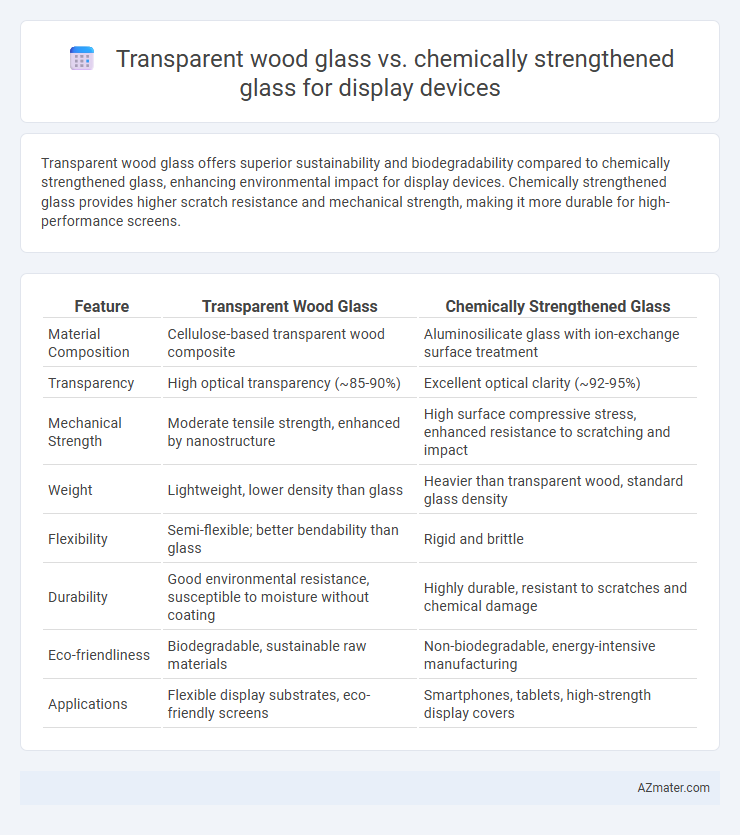Transparent wood glass offers superior sustainability and biodegradability compared to chemically strengthened glass, enhancing environmental impact for display devices. Chemically strengthened glass provides higher scratch resistance and mechanical strength, making it more durable for high-performance screens.
Table of Comparison
| Feature | Transparent Wood Glass | Chemically Strengthened Glass |
|---|---|---|
| Material Composition | Cellulose-based transparent wood composite | Aluminosilicate glass with ion-exchange surface treatment |
| Transparency | High optical transparency (~85-90%) | Excellent optical clarity (~92-95%) |
| Mechanical Strength | Moderate tensile strength, enhanced by nanostructure | High surface compressive stress, enhanced resistance to scratching and impact |
| Weight | Lightweight, lower density than glass | Heavier than transparent wood, standard glass density |
| Flexibility | Semi-flexible; better bendability than glass | Rigid and brittle |
| Durability | Good environmental resistance, susceptible to moisture without coating | Highly durable, resistant to scratches and chemical damage |
| Eco-friendliness | Biodegradable, sustainable raw materials | Non-biodegradable, energy-intensive manufacturing |
| Applications | Flexible display substrates, eco-friendly screens | Smartphones, tablets, high-strength display covers |
Introduction to Display Device Glass Technologies
Transparent wood glass offers lightweight, eco-friendly alternatives with enhanced mechanical strength and optical clarity for display devices. Chemically strengthened glass, such as aluminosilicate variants, provides superior scratch resistance and durability through ion-exchange processes, making it ideal for high-performance displays. Both materials advance display technology by balancing transparency, toughness, and environmental impact in modern consumer electronics.
What is Transparent Wood Glass?
Transparent wood glass is an innovative material combining natural wood fibers with resin to create a lightweight, shatter-resistant alternative to traditional glass for display devices. It offers superior impact resistance and better thermal insulation compared to chemically strengthened glass, which undergoes ion exchange processes to enhance surface hardness and durability. This material's unique cellular structure allows for high optical clarity while maintaining environmental sustainability and renewable sourcing.
Overview of Chemically Strengthened Glass
Chemically strengthened glass undergoes an ion-exchange process that replaces smaller sodium ions with larger potassium ions, creating a layer of compressive stress on the surface and significantly enhancing its strength and scratch resistance. This glass variant is widely used in display devices such as smartphones, tablets, and monitors due to its superior durability and resistance to impact compared to conventional glass. The enhanced mechanical properties improve device longevity while maintaining high optical clarity and touch sensitivity essential for consumer electronics.
Material Composition and Structure Comparison
Transparent wood glass consists of cellulose fibers embedded within a polymer matrix, creating a composite material with high optical transparency and mechanical flexibility. Chemically strengthened glass, such as aluminosilicate glass, undergoes ion exchange processes to create compressive stress layers on the surface, enhancing hardness and impact resistance. The key structural difference lies in transparent wood's porous, fibrous network combined with polymers versus the homogenous, densely packed atomic structure of chemically strengthened glass, impacting durability and flexibility for display devices.
Optical Clarity and Light Transmission
Transparent wood glass exhibits high optical clarity and superior light transmission due to its natural cellulose structure combined with polymer infiltration, resulting in minimal light scattering and haze levels below 5%. Chemically strengthened glass offers excellent transparency with light transmission rates around 90%, but it can suffer from slight surface distortion affecting clarity under certain angles. The organic composition of transparent wood glass enhances its optical uniformity, making it a promising alternative for next-generation display devices requiring high visual fidelity.
Mechanical Strength and Durability
Transparent wood glass exhibits superior mechanical strength and durability compared to chemically strengthened glass due to its natural fiber-reinforced structure, which enhances impact resistance and flexibility. The lignocellulosic composition of transparent wood enables it to absorb and dissipate stress more effectively, reducing the risk of cracking under pressure. Chemically strengthened glass, while harder on the surface and scratch-resistant, tends to be more brittle and prone to shattering under high impact, limiting its long-term durability in display devices.
Manufacturing Processes and Scalability
Transparent wood glass undergoes a process involving delignification, impregnation with polymers, and curing, enabling lightweight, shatter-resistant panels with natural flexibility. Chemically strengthened glass is produced through an ion exchange process where smaller sodium ions are replaced by larger potassium ions, enhancing surface compressive stress and significantly improving scratch resistance and durability. Manufacturing scalability favors chemically strengthened glass due to established mass-production techniques, whereas transparent wood glass remains limited by complex processing steps and material uniformity challenges.
Sustainability and Environmental Impact
Transparent wood glass offers a renewable alternative by utilizing bio-based materials, reducing carbon footprint and enhancing biodegradability compared to chemically strengthened glass made from silica and harsh chemicals. The manufacturing process of transparent wood involves fewer toxic substances, lowering environmental pollution and energy consumption. Chemically strengthened glass, while durable, relies on energy-intensive ion-exchange treatments and non-renewable resources, making transparent wood a more sustainable solution for eco-friendly display devices.
Cost Effectiveness in Mass Production
Transparent wood glass offers a cost-effective alternative to chemically strengthened glass by utilizing abundant lignin and cellulose materials, significantly reducing raw material expenses in mass production. The manufacturing process of transparent wood involves less energy-intensive steps compared to the high-temperature ion-exchange treatments required for chemically strengthened glass, further lowering production costs. However, chemically strengthened glass remains more scalable with established supply chains, while transparent wood technology is still advancing toward industrial-level cost optimization.
Future Prospects: Transparent Wood Glass vs. Chemically Strengthened Glass
Transparent wood glass offers lightweight, eco-friendly alternatives with tunable optical and mechanical properties, ideal for future flexible and biodegradable display devices. Chemically strengthened glass remains dominant due to its superior hardness, scratch resistance, and established manufacturing processes, ensuring reliability in high-performance, durable displays. Innovations in transparent wood composites could reduce weight and environmental impact, positioning them as promising candidates in next-generation flexible and sustainable display technologies.

Infographic: Transparent wood glass vs Chemically strengthened glass for Display device
 azmater.com
azmater.com